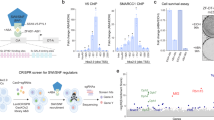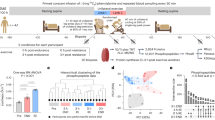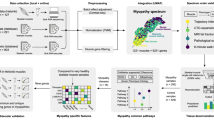Abstract
During skeletal myogenesis, genomic reprogramming toward terminal differentiation is achieved by recruiting chromatin-modifying enzymes to muscle-specific loci1,2. The relative contribution of extracellular signaling cascades in targeting these enzymes to individual genes is unknown. Here we show that the differentiation-activated p38 pathway3,4,5 targets the SWI-SNF chromatin-remodeling complex to myogenic loci. Upon differentiation, p38 kinases were recruited to the chromatin of muscle-regulatory elements. Blockade of p38α/β repressed the transcription of muscle genes by preventing recruitment of the SWI-SNF complex at these elements without affecting chromatin binding of muscle-regulatory factors and acetyltransferases. The SWI-SNF subunit BAF60 could be phosphorylated by p38α-β in vitro, and forced activation of p38α/β in myoblasts by expression of a constitutively active MKK6 (refs. 5,6,7) promoted unscheduled SWI-SNF recruitment to the myogenin promoter. Conversely, inactivation of SWI-SNF enzymatic subunits abrogated MKK6-dependent induction of muscle gene expression. These results identify an unexpected function of differentiation-activated p38 in converting external cues into chromatin modifications at discrete loci, by selectively targeting SWI-SNF to muscle-regulatory elements.
This is a preview of subscription content, access via your institution
Access options
Subscribe to this journal
Receive 12 print issues and online access
$259.00 per year
only $21.58 per issue
Buy this article
- Purchase on SpringerLink
- Instant access to full article PDF
Prices may be subject to local taxes which are calculated during checkout




Similar content being viewed by others
References
Sartorelli, V. & Puri, P.L. The link between chromatin structure, protein acetylation and cellular differentiation. Front. Biosci. 6, D1024–D1047 (2001).
McKinsey, T.A., Zhang, C.L. & Olson, E.N. Signaling chromatin to make muscle. Curr. Opin. Cell Biol. 14, 763–772 (2002).
Cuenda, A. & Cohen, P. Stress-activated protein kinase-2-p38 and a rapamycin-sensitive pathway are required for C2C12 myogenesis. J. Biol. Chem. 274, 4341–4346 (1999).
Zetser, A., Gredinger, E. & Bengal, E. p38 mitogen-activated protein kinase pathway promotes skeletal muscle differentiation. Participation of the Mef2c transcription factor. J. Biol. Chem. 274, 5193–5200 (1999).
Wu, Z. et al. p38 and extra-cellular signal-regulated kinases regulate the myogenic program at multiple steps. Mol. Cell. Biol. 20, 3951–3964 (2000).
Puri, P.L. et al. Induction of terminal differentiation by constitutive activation of p38 MAP kinase in Human rhabdomyosarcomas. Genes Dev. 14, 574–584 (2000).
Raingeaud, J. et al. MKK3- and MKK6-regulated gene expression is mediated by the p38 mitogen activated protein kinase signal transduction pathway. Mol. Cell. Biol. 16, 1247–1255 (1996).
Bergstrom, D.A. et al. Promoter-specific regulation of MyoD binding and signal transduction cooperate to pattern gene expression. Mol. Cell 3, 587–600 (2002).
Han, J. et al. Activation of the transcription factor MEF2C by the MAP kinase p38 in inflammation. Nature 386, 296–299 (1997).
Zhao, M. et al. Regulation of the MEF2 family of transcription factors by p38. Mol. Cell. Biol. 19, 21–30 (1999).
Puri, P.L. & Sartorelli, V. Regulation of muscle regulatory factors by DNA-binding, interacting proteins, and post-transcriptional modifications. J. Cell Physiol. 185, 155–173 (2000).
Puri, P.L. et al. Differential roles of p300 and PCAF acetyltransferases in muscle differentiation. Mol. Cell 1, 35–45 (1997b).
de la Serna, I.L., Carlson, K.A. & Imbalzano, A.N. Mammalian SWI-SNF complexes promote MyoD-mediated muscle differentiation. Nat. Genet. 27, 187–190 (2001).
Saccani, S., Pantano, S. & Natoli, G. p38-Dependent marking of inflammatory genes for increased NF-kappa B recruitment. Nat. Immunol. 1, 69–75 (2002).
Sartorelli, V. et al. Acetylation of MyoD directed by PCAF is necessary for the execution of the muscle program. Mol. Cell 4, 725–734 (1999).
Polesskaya, A. et al. CREB-binding Protein-p300 activates MyoD by acetylation. J. Biol. Chem. 275, 34359–34364 (2000).
Fulco, M. et al. Sir2 regulates skeletal muscle differentiation as a potential sensor of the redox state. Mol. Cell 12, 51–62 (2003).
Roy, K., de la Serna, I.L. & Imbalzano, A.N. The myogenic basic helix-loop-helix family of transcription factors shows similar requirements for SWI-SNF chromatin remodeling enzymes during muscle differentiation in culture. J. Biol. Chem. 277, 33818–33824 (2002).
Gerber, A.N., Klesert, T.R., Bergstrom D.A. & Tapscott, S.J. Two domains of MyoD mediate transcriptional activation of genes in repressive chromatin: a mechanism for lineage determination in myogenesis. Genes Dev. 11, 436–450 (1997).
Wilson, C.J. et al. RNA polymerase II holoenzyme contains SWI-SNF regulators involved in chromatin remodeling. Cell 2, 235–244 (1996).
Black, B.L., Molkentin, J.D. & Olson, E. Multiples roles for the MyoD basic region in transmission of transcriptional activation signals and interaction with Mef2. Mol. Cell. Biol. 18, 69–77 (1998).
Hsiao, P.W., Fryer, C.J., Trotter, K.W., Wang, W. & Archer, T.K. BAF60a mediates critical interactions between nuclear receptors and the BRG1 chromatin-remodeling complex for transactivation. Mol. Cell. Biol. 23, 6210–6220 (2003).
Debril, M.B. et al. Transcription factors and nuclear receptors interact with the SWI-SNF complex through the BAF60c subunit. J. Biol. Chem. 16, 16677–16686 (2003).
Muchardt, C. & Yaniv, M. A human homologue of Saccharomyces cerevisiae SNF2-SWI2 and Drosophila brm genes potentiates transcriptional activation by the glucocorticoid receptor. EMBO J. 11, 4279–4290 (1993).
Khavari, P.A., Peterson, C.L., Tamkun, J.W., Mendel, D.B. & Crabtree, G.R. BRG1 contains a conserved domain of the SWI2-SNF2 family necessary for normal mitotic growth and transcription. Nature 366, 170–174 (1993).
Neely, K.E. et al. Transcription activator interactions with multiple SWI-SNF subunits. Mol. Cell. Biol. 6, 1615–1625 (2002).
Kadam, S. & Emerson, B.M. Transcriptional specificity of human SWI-SNF BRG1 and BRM chromatin remodeling complexes. Mol. Cell 2, 377–389 (2003).
Hassan, A.H., Neely, K.E. & Workman, J. Histone acetyltransferases complexes stabilize SWI-SNF binding to promoter nucleosomes. Cell 104, 817–827 (2001).
Sif, S., Stukenberg, P.T., Kirschner, M.W. & Kingston, R.E. Mitotic inactivation of a human SWI-SNF chromatin remodeling complex. Genes Dev. 18, 2842–2851 (1998).
Acknowledgements
We thank J. Feramisco for continuous support to the project and for providing the microinjection facility; M. Montminy for support to P.L.P. and C.S.; C. Buckmaster for technical assistance in microinjection; J. Feramisco, V. Sartorelli, J.Y.J. Wang and members of the laboratory of P.L.P. for discussions and critical reading of the manuscript; V. Sartorelli for antibodies to acetylated MyoD; E. Knudsen for BRM, BRG1 and BRG1 (K798R) enzymatic-deficient mutant cDNA; J. Han for antibodies to MEF2c; T. Sudo for antibodies to p38α; and R. Evans for SW13 cells. This project was partially supported by MDA (Research Developmental Grant to P.L.P.) and by Compagnia San Paolo di Torino to Dulbecco Telethon Institute. C.S. was supported by a Telethon fellowship and Sbarro Health Research Organization. S.V.F. is supported by a Marie Curie fellowship.
Author information
Authors and Affiliations
Corresponding author
Ethics declarations
Competing interests
The authors declare no competing financial interests.
Supplementary information
Supplementary Fig. 1
Time course of the assembly of myogenic transcriptosome. (PDF 355 kb)
Supplementary Fig. 2
Comparative analysis of chromatin bound factors at Ckm enhancer and coding sequence. (PDF 575 kb)
Supplementary Fig. 3
ChIP from C2C12 myoblasts cultured in GM and stimulated with TNFa (10 ng/ml) for 1 h with or without SB. (PDF 230 kb)
Supplementary Fig. 4
ChIP from 2C12 myoblasts cultured in GM or induced to differentiate (DM) with or without SB. (PDF 263 kb)
Rights and permissions
About this article
Cite this article
Simone, C., Forcales, S., Hill, D. et al. p38 pathway targets SWI-SNF chromatin-remodeling complex to muscle-specific loci. Nat Genet 36, 738–743 (2004). https://doi.org/10.1038/ng1378
Received:
Accepted:
Published:
Issue date:
DOI: https://doi.org/10.1038/ng1378
This article is cited by
-
Uncoupling p38α nuclear and cytoplasmic functions and identification of two p38α phosphorylation sites on β-catenin: implications for the Wnt signaling pathway in CRC models
Cell & Bioscience (2023)
-
Distinctive epigenomic alterations in NF1-deficient cutaneous and plexiform neurofibromas drive differential MKK/p38 signaling
Epigenetics & Chromatin (2021)
-
Pharmacological targeting of the novel β-catenin chromatin-associated kinase p38α in colorectal cancer stem cell tumorspheres and organoids
Cell Death & Disease (2021)
-
Prmt7 promotes myoblast differentiation via methylation of p38MAPK on arginine residue 70
Cell Death & Differentiation (2020)
-
Regulation of senescence traits by MAPKs
GeroScience (2020)



